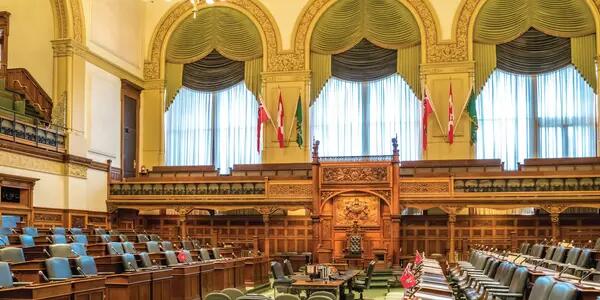
Latest updates
- Negotiations are underway. Show your AMAPCEO swag in the workplace!
- Learn more about how Bill 124 affects collective bargaining.
- Your FRA Bargaining Team members have been announced.
- Make sure your personal email with AMAPCEO is up to date by visiting your Member Dashboard and clicking Edit Profile.
Last updated: January 11, 2023
Highlights from the Tentative Agreement
Term
-
A three-year term, aligned with Bill 124’s mandated 1% moderation period.
-
April 1, 2022–March 31, 2025
Maximum compensation increases
Across-the-Board Salary Increases
- Under the tentative deal, AMAPCEO-represented employees will receive the maximum compensation increases allowable under Bill 124 to individual salaries and to all salary ranges. These are:
- 1% on April 1, 2022
- 1% on April 1, 2023
- 1% on April 1, 2024
- Annual merit pay provisions are not impacted by Bill 124 and will continue.
Protected Rights to Obtain a Bill 124 Remedy
- The tentative deal includes an agreement that AMAPCEO retains the right to seek a remedy relating to compensation in excess of 1%, in the event that its challenge to Bill 124 is successful. This is similar to what other unions have bargained, including in the education sector.
- AMAPCEO is a member of a coalition of public sector unions challenging Bill 124 in court, although if the challenge is successful, it will likely take several years until the issue of remedy is determined.
Would the across-the-board 1% be retroactive?
Yes, the 1% across-the-board compensation increase for April 1, 2022 would be retroactive for everyone, including those who have since left the OPS.
Some public sector unions have been offered increases of more than 1% year. Why not us?
Bill 124 caps public sector unions’ compensation increases at 1% for the first three years of their next contract. This is called the “moderation period.”
Many public sector unions outside of the OPS, including teachers and education workers, have already had Bill 124 applied for three years (2019-2022) and have therefore completed their moderation period.
AMAPCEO members have not. Like the other OPS unions before us, we have negotiated a three-year deal so the next contract (in 2025) will not be affected by Bill 124.
Why didn’t we demand more than 1% a year?
Under Bill 124, a 1% compensation increase is the maximum legal increase for AMAPCEO members for the first three years of our next contract.
AMAPCEO is a founding member of the coalition that is challenging Bill 124 in court as being unconstitutional. If the bill is struck down, the tentative agreement has preserved our right to seek a remedy relating to compensation in excess of 1% in the event our challenge to the legislation is successful.
I’m retiring or planning on leaving the OPS over the next few years. Would any remedy obtained through the court challenge be retroactive to me?
If AMAPCEO and other unions are successful with our challenge of Bill 124 in the courts, a financial remedy for damages may be a potential outcome. Such an outcome would require further litigation to decide on the appropriate remedy, including whether there would be any retroactivity for all those employed at the time of Bill 124’s impact on the bargaining unit.
Collective bargaining occurs when a group of people in a workplace band together to increase their negotiating power.
Learn more about the collective bargaining process.
This legislation limits public sector workers’ compensation increases to a maximum of one per cent a year for three years—including for unionized workers as their contracts expire.
Learn more about Bill 124 and how it affects us.
Frequently asked questions
What is collective bargaining?
Collective bargaining occurs when a group of people in a workplace band together to increase their negotiating power. There is a greater likelihood of success together than there is apart, so it is also about demonstrating our collective will and resolve.
These negotiations between employees and management lead to a legally binding collective agreement that details many of the terms and conditions of our employment, including wages, working conditions, job security, and more.
This collective agreement also ensures the employer consults with us and that we work collaboratively to seek solutions on matters that affect us. It means our workplaces are governed with transparency and fairness.
When does bargaining start?
The current OPS Collective Agreement runs until March 31, 2025.
The existing terms and conditions of the current collective agreement remain frozen in place until a new collective agreement comes into effect. The new agreement may have retroactive measures.
How will I get updates during bargaining?
Make sure your contact information with AMAPCEO is up-to-date, and that you are subscribed to receive our emails. Visit our Subscribe page if you haven’t opted-in to receive our emails.
Signed members also receive exclusive updates and event invitations. If you haven’t become a signed member of AMAPCEO, you can do so at no additional cost at amapceo.ca/membership.
We will also continually update this webpage with updates as they become available. And the union’s leadership will meet with members either virtually or in-person, as public health regulations permit, to update members on progress.
How are our bargaining goals set?
Every AMAPCEO member will take part in a survey asking them where they desire improvements to the current collective agreement. It is very important that you complete this survey and make sure your voice is heard.
The survey results will be provided to the bargaining team, staff, and union leadership to draft the broad bargaining priorities, which are typically shared with Delegates at the Annual Delegates’ Conference.
These results, further informed by research, additional consultation, and legal advice, will be used to generate more specific bargaining plans. The Board of Directors is ultimately responsible for reviewing and approving this mandate.
Why is it important to support my colleagues and union during bargaining?
We have worked hard to achieve the current terms and conditions of our employment. Supporting your colleagues, the bargaining team, and our union, helps demonstrate our collective strength and our resolve to securing a fair contract. We are stronger together.
Union leadership and local AMAPCEO activists may also ask you to take specific actions to demonstrate your solidarity. This could include displaying a flag on your desk, using a union background during a video call, or attending an event.
These actions serve as proof of member cohesion and support for AMAPCEO. This can speed up the bargaining process and result in improved collective agreements for all members.
More broadly, unions helped build the middle class in Canada. The eight-hour workday, pensions, minimum wages, employment standards, equal pay, health and safety legislation, pregnancy and parental leave, and other provisions were first negotiated by unionized workers and then extended to others.
Since the 1990s, however, unions have been under attack—first in the private sector and now in the public sector. It’s important that we bust unfair myths and build collective power for the benefit of all.
Does collective bargaining lead to a strike?
The priority in our negotiations has always been to achieve a fair collective agreement without any unnecessary use of job action. AMAPCEO has always fought for alternatives to labour disruptions in the event of a bargaining impasse and has never had to go on strike.
However, if the employer creates issues during negotiations, a labour disruption remains an important tool in the union’s toolbox. Labour disruption is a broad term encompassing a spectrum of possibilities—small, such as a local lunch-time rally or a refusal to work overtime, to large, such as a province-wide walkout or strike.
Union-initiated labour disruptions are governed by a legal process that unfolds over several weeks. A union cannot call a strike without first having its members vote in favour of such an action. A positive vote does not guarantee that a job action will take place. It is a clear message to the employer side that AMAPCEO members are serious about achieving certain demands in bargaining.


